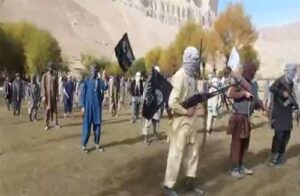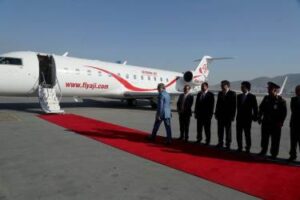KABUL (SW): In an exclusive interview with the Salam Watandar, William (Bill) Hammink, USAID Mission Director for Afghanistan, expressed confidence about the Kabul government’s reform agenda in terms of using funds and ensuring transparency.
Hammink, who has been in Afghanistan since July 2013, spoke about a range of issues from the US’s long-term civilian engagement in Afghanistan to improving health, education, infrastructure, economy, governance and strengthen the civil society.
Referring to the National Procurement Authority (NPA), reforms in the civil services, public financial management reforms and others, he said this shows strong commitment to move forward on a number of key areas for the government to function.
“The President [Ashraf Ghani] and Chief Executive Officer [Abdullah Abdullah] telling the donors they don’t want just so many little projects anymore, they want programs in sector assistance in trying to achieve strategic goals together, so these are really important changes”, he remarked.
“USAID aims to stay in Afghanistan for long”
William Hammink made it clear that the US’s civilian engagement in Afghanistan was to continue even after the withdrawal of the armed forces.
NATO has maintained 13,000 troops including 9,800 Americans in an advisory and counter-terrorism capacity in Afghanistan and they are expected to pull out as well by the end of 2016.
Recalling the engagements of President Ashraf Ghani and CEO Abdullah Abdullah during their state visit to the U.S. earlier in March, Hammink mentioned that it was agreed between Ghani, Abdullah and the US President Barack Obama to work together for a new development partnership.
“It really is a new way of working together as partners looking for the future, and US government has decided to set aside up to $ 800 million, this is the world supporting the Afghan government’s own reform agenda”, he said.
Responding to a question about the policy regarding short term thinking and support to rapid and visible result projects, the USAID Mission Director agreed that this approach remained the case in the early days. “But, I can tell, over the last several years, USAID has significantly shifted [as to] how we do business here”, he added.
According to him, much more focus has been shifted to capacity building and institutional developments in line with long term goals.
The USAID Mission Director made it clear that his organization is planning to stay in Afghanistan for many years to come and continue development and aid work in line with the government’s Decade of Transformation Plan (DTP 2015-2024).
According to Afghanistan’s Ministry of Foreign Affairs (MoFA), the country aims to achieve self reliance in various fields by pursuing this plan.
Afghanistan to shoulder responsibility
The Kabul government and its international backers have agreed on a mechanism according to which Afghanistan has to meet certain agreed-upon indicators that proves certain reform or actionable results have been achieved. In return, the Afghan government would receive funds through Afghanistan Reconstruction Trust Fund (ARTF).
Underlining the fact that ultimately the Afghan government and people need to take responsibility of their affairs, Hammink noted that much more was needed to be done with regard to curbing the issue of malnutrition and low literacy level and ensuring a vibrant economy with agriculture playing a key role.
“Sadly, there is something like a 42 percent malnutrition rate in children under the age of 5, which is very high in the world, we co-sponsor with ministry of Public Health and UNICEF to focus on bringing down maternal mortality and bring down infant mortality”, he said.
Lauding the improvement made in Afghanistan during the past decade in comparison with other under-developed countries, he said the USAID has been busy in around 80 countries around the world and development takes time. “It is a marathon, not a sprint race”.
Key areas of interest for the USAID
The USAID remains top assistance provider to the reconstruction drive in the war-torn Afghanistan for over a decade now. Hammink said improving the agriculture value chain has become one of their top priorities.
Talking to SW, he highlighted the projects underway in all four zones of the country to support Afghan farmers, traders and processors that have yield significant increase in exports.
Hammink also mentioned the heavy transmission line providing electricity to the southern provinces from the capital Kabul. “We are working closely with public and private sector on expanding clean and renewable energy, there is a huge potential here for solar and wind and in that way Afghanistan can become less dependent on imported energy”, he noted.
Afghanistan heavily relies on imported electricity mainly from the Central Asian countries. A 20-year power purchase agreement (PPA) was signed between Afghanistan and Tajikistan on August 29, 2008. A total of up to 130-170 MW is expected to be supplied over the NEPS network in 2010 to Kabul and 30 MW to Mazar-e-Sharif from Uzbekistan.
Support for the media that is the voice of accountability would continue, Hammink remarked.
About the USAID’s flagship women empowerment program PROMOTE that was launched in November last year, Hammink said around thousands of Afghan women and girls would benefit from it.
“The vision is to encourage, support and train women and girls between the age of 18 and 35 in various segments of the society to lead the society alongside men in the future”, he added.
Hammink further said that the US is also keen to help Afghanistan in discussions with neighbouring countries in terms of trade agreements.
“Funds are tracked closely”
In a string of hard-hitting reports, the Special Inspector General for Afghanistan Reconstruction (SIGAR) has claimed millions of dollars have been wasted in Afghanistan. According to SIGAR reports, the US has spent some $110 billion on Afghanistan's reconstruction but a noteworthy amount of this aid money has been ‘wasted’.
About such report, Hammink said the role of inspectors was always welcomed. “We work very closely with the ministries in terms of accuracy of the data, in terms of accountability; all USAID funds we track closely” he said.
At the end, William Hammink, USAID Mission Director said clearly there are huge problems in Afghanistan but it is very important to underline that USAID and the civilian side of US government is planning to be here for many years to come. “Our commitment is strong in terms of our continued development assistance and cooperation for development with the Afghan people and with the Afghan government for years to come.”
ENDS





